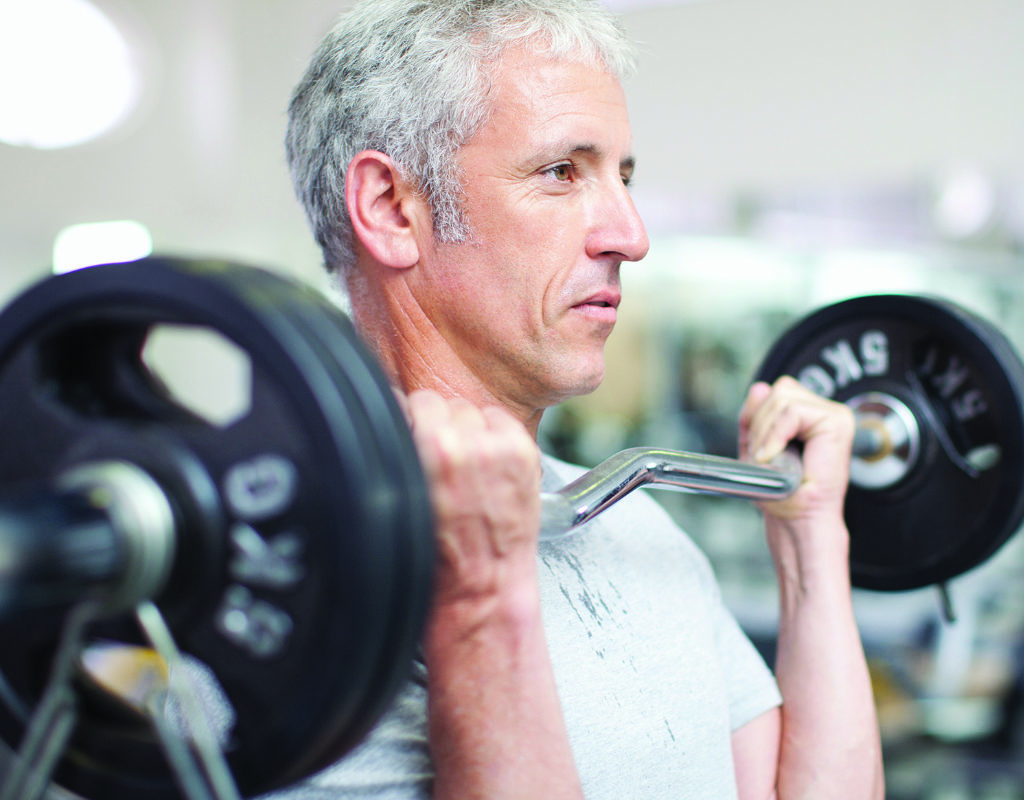Fight Back Against Aging With Strength Training

By Nick Rizzo
Canada’s population has been steadily aging. As of 2014, seniors were making up 15.6% of the population (approximately 6 million). By 2030, estimates expect that number to rise significantly to over 9.5 million seniors that account for more than 23% of Canadians.
With life expectancy increasing and the baby boomers still entering their senior years, these numbers are expected to keep rising, which is why there is a need now, more than ever, for more personal trainers, nutritionists, fitness instructors, and weight loss coaches to garner a greater understanding of seniors and the best ways to serve them. One way to better understand seniors is to first take a look at how aging impacts the body.
Four Impacts of Aging on the Body
1) Age-related loss in muscle mass (and sarcopenia)
The unfortunate fact is this, aging inherently leads to seniors losing muscle mass. At first, it can be a bit slow. But, from age 50 on the rate of decrease starts to pick up. At this milestone, you start losing muscle at a rate of 1-2% every year. If left unaddressed, this can develop into significant issues like sarcopenia, which, up to 13% of those aged 60-70 suffer from. Then, looking at the 80+ crowd, it is clear that this issue has continued to progress since as much as 50% of this population struggle with the health issues of sarcopenia.
2) Deterioration in strength over time
As you continue to lose muscle, you are also going to be losing your strength. Those above the age of 60 are estimated to lose as much as 3% of their strength every calendar year. This is troubling for a slew of reasons, but no more troubling than this next point.
3) The degradation of functional capabilities and functional independence
As muscle and strength decline, basic functional capabilities start to become harder and more difficult. Overall mobility and flexibility begin to take a hit as well. As these capabilities begin to degrade, it starts to limit overall physical activity which only further expedites the loss of functional capabilities. With this comes a continuous loss in seniors’ abilities to simply be functionally independent and living life by their own means.
4) Slowing down your metabolism and increasing obesity
The three above points all play a role in packing on the pounds as you age. Muscle mass is beneficial for more than looking good, mobility, and strength – having higher levels of muscle mass leads to a direct increase in one’s metabolic rate.
A decrease in strength causes speed, intensity and power generated in your day-to-day activities to significantly decrease as well. This means you are utilizing less energy, burning fewer calories, and missing the benefits of more intense physical activity.
The loss of functional capabilities inherently leads to a more sedentary lifestyle. Being less physically active overall is only going to further decrease your metabolism, increase weight gain, and a whole host of other issues.
All of this is dangerous – continually adding on weight while being less and less active can bring upon other health concerns like heart disease and diabetes.
It is clear that all of these aspects are all interconnected. But what is the best way to fight back against these issues?
Strength training: Five benefits for the 65+ population
Weight lifting to build muscle and increase strength is easily one of the most important things that the aging population needs to be engaged in. In fact, a meta-analysis analyzed over 120 peer-reviewed studies and identified 78 benefits of strength training for seniors. It addresses everything from the topics we are touching on here to cognitive health, mental health, reducing fall risk factors, reducing mortality rates, and much more.
But, even if we focus just on the issues listed above, it is clear that strength training is critical. Here’s why.
1) First of all, it’s safe
The amount of times I have heard people spread the myth that lifting weights is dangerous for older folks is mind numbing. I have even seen trainers refuse older clients because “they should just walk at the mall”. Infuriating. So let’s do away with this myth first and foremost. Study after study has shown that not only is it safe, it is extremely effective for a whole bunch of reasons.

2) The best prescription for preventing and reversing sarcopenia
A lot of people, my father being one of them, didn’t think that they would be able to really see any improvements in their muscle mass. The question is always something like “I am just too old, will this really work?”
The answer is a hard yes.
Whether your 50 years old or 90 years old, you can still build muscle. In fact, even just doing one set of exercises three times a week has been shown to produce significant improvements in muscle mass. Increasing the sets, reps, intensity or number of exercises leads to a dramatic boost in benefits.
By starting earlier, rather than later, you can actually prevent the decline from ever occurring. But, if you haven’t started, it isn’t too late. As studies have seen, volunteers aged 61-80 can see dramatic improvements of their current health status, with volunteers being able to add over two pounds of muscle mass in 10-12 weeks, which reduced their physical age by five years on average.
3) Best way to maintain strength and improve it
No matter the age, strength training will improve general functional strength, maximal strength, endurance, and conditioning.
Being ahead of the curve has its benefits. Those who had been strength training as a regular way of life were protected against significant losses in strength.
But don’t be confused, just being physically active isn’t the same. When one study compared populations of strength training masters and physically active seniors, the masters had greater strength, functional capabilities, functional performance, and more.
4) Fighting back against obesity
The obvious is that exercise is going to help fight back against obesity. What isn’t obvious is what sets strength training apart from other forms of exercise.
One study demonstrated that hitting the weights over the course of 10 weeks was able to reduce more than 1.8kg of fat mass. All the while, the participants saw their average metabolic rate increase by as much as 7%.
Another aspect is that load-bearing exercises are known for significantly elevating metabolic rates for 12-48 hours post-workout. Adding this on top of the already elevated resting metabolic rate will help to utilize more calories and increase your daily energy expenditure to drop fat.
A third way that isn’t talked about as much revolves around a singular hormone known as isrin. Lifting weights increases the levels of this hormone (while also improving other aspects of your endocrine system). What isrin does is help promote “good fat” while also decreasing “bad fat”.
You see, if you live a more sedentary lifestyle, the type of fat you are more likely to have is known as white fat (bad fat). This type of fat tissue is not metabolically active. It doesn’t produce much energy or burn many calories.
On the other hand, brown fat (good fat) is the complete opposite. These brown fat cells are packed with mitochondria that are highly metabolically active. Having higher levels of brown fat vs white fat leads to overall great fat loss.
Coming back to isrin… isrin works to actively convert white fat into brown fat. By working out more you can keep the levels of isrin elevated to continually improve the ratio of white to brown fat.
5) Staying physically fit to keep that functional independence
Last but not least, lifting will help you to stay functionally independent.
Seniors that were hitting the gym were able to see physical capabilities improve across the board. Studies demonstrated significant increases in:
- Walking speed and step length
- Performance and time of doing tasks like sitting down, standing up, climbing stairs, and walking
- The flexibility of every single joint movement
- Overall mobility
- Static and dynamic balance
- Movement control due to improved neuromuscular functioning
With these improvements, seniors can expect to reduce fall risk factors. With that, they may experience improved confidence in their movement which helps to reduce their fear of falling – a fear that can be restrictive and paralyzing from even attempting to be active.
Active living: Are you ready to help seniors with active aging?
The goal of this article is to simply help you understand this aging population and the struggles they may endure. Just simply strength training two to three times a week can be absolutely critical to having a long, healthy, and active life.
With that said, there is so much more you can do to help older adults. If you want to become someone that older clients can look to for “all of the above”, look into earning your Personal Training Specialist Certification and the corresponding Active Aging Certificate from canfitpro. You will get a deep dive into the impact and physiology of aging, healthy eating, the crucial type of exercises for older adults, and even how to adapt regiments for specific conditions or illnesses they may be struggling with.

